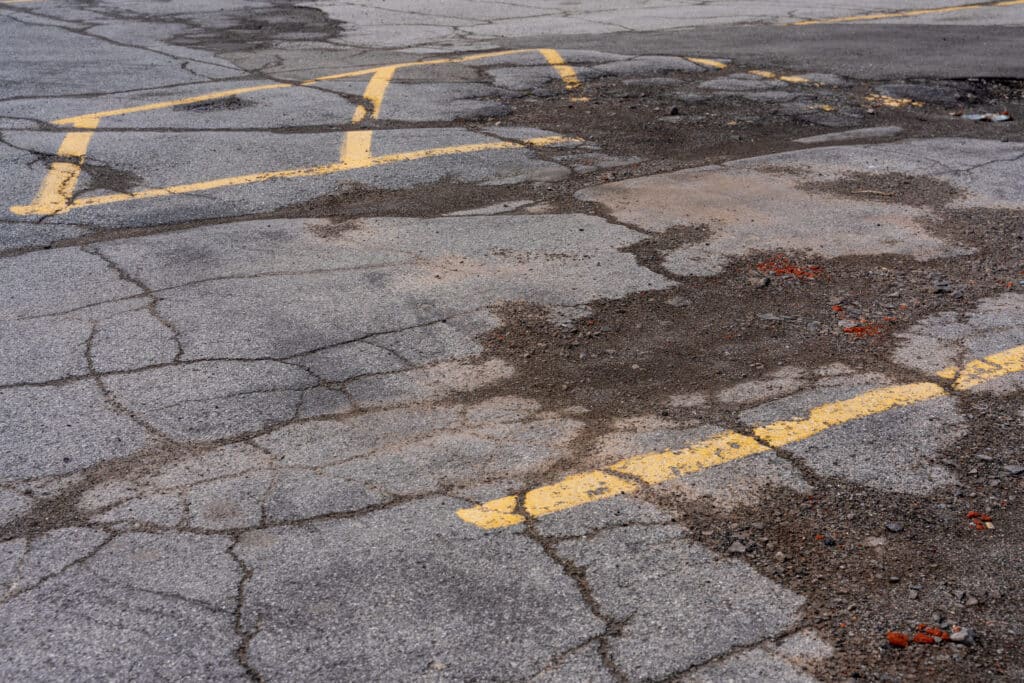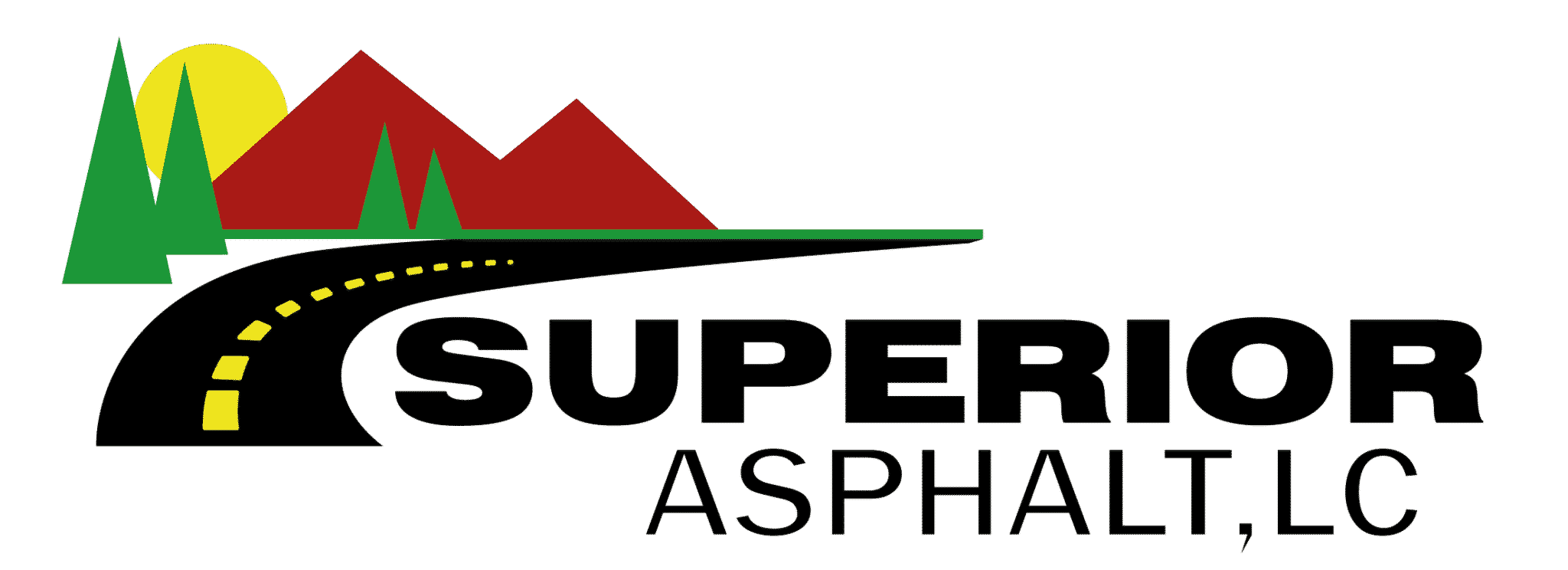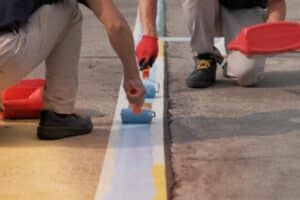If you’re a business owner or parking lot owner in Utah, it’s essential to know the fire code requirements for your parking lot stripes. This guide will provide the information you need to ensure that your parking lot complies with all fire code requirements. From asphalt condition standards to the number of exits, here’s everything you should know about fire code laws before painting parking lot stripes.
The Basics of Parking Lot Marking Compliance
When it comes to parking lot marking compliance, there are three factors to consider when striping or restriping a lot — fire lanes, handicap spaces, and standard parking spaces. Parking lot owners and management must follow both city parking lot codes and state parking lot codes or risk serious liability issues. Parking lot lanes that aren’t compliant with local and state legislature risk fines, vehicle accidents, and pedestrian safety.
Below we’ll break down the three core basics of parking lot marking compliance.
Fire Lanes
Fire lanes ensure that fire departments and emergency responders can easily access your parking lot when necessary. Without fire lane markings, parking lot owners risk vehicles parking in these designated areas which can obstruct fire and emergency officials from responding adequately and risk serious consequences from local sanctions.
Depending on local and state legislature, fire lanes laws for parking lots typically include:
- Lot area and height size requirements
- Minimum building distance requirements
- Fire lane markings, stripes, and signs
- Minimum fire hydrant distance and access
- Number of exits based on lot space
According to the National Fire Protection Association (NFPA), parking lots are required to paint fire lanes within specific location requirements, depending on lot size, and local and state regulations.
Some of the NFPA’s requirements for parking lot fire lanes include:
- At least 20ft wide 13.5 ft vertical clearance in access roads from parking lots into the buildings
- Regular fire lane striping and asphalt maintenance for parking lots and access roads
- Elevation must not exceed 1ft for every 20 ft unless local fire codes dictate otherwise
Whether it’s a new parking lot design or parking lot restriping, following fire lane regulations is more than painting a fire lane outside a building. Fire lanes are required by law for commercial property owners in case of fire and health emergencies.
Handicapped Spaces
Next on the list of parking lot compliance basics is having designated handicap spaces and markings. Handicap parking is required for lot owners to provide for people with disabilities who have difficulty walking or use mobility devices.
For this reason, it’s crucial for business owners to understand ADA guidelines for parking lots. The Americans with Disabilities Act (ADA) sets regulations so people with disabilities have equal access to public spaces — including parking lots.
Some car ADA requirements for parking lots include:
- Clearly marked handicap access aisles and spaces — at least 96 in wide
- Leveled parking surface — no more than 2.08% slope in all directions with a firm, stable, and slip-resistant surface
- Same parking space length as access aisles – at least 96 in wide
- Clearly marked handicap signs — use the international symbol of accessibility at least 60 in above the ground
- Minimum number of handicapped parking spaces — total spaces required calculated by lot size
There are also ADA regulations for vans and special parking conditions for lots with limited parking spaces. Whether it’s new parking lot striping or parking lot restriping, ADA standards require accessible and safety features for people with disabilities which must be considered before painting.
This includes restriping faded handicap parking stripes, fixing crumbling asphalt, leveling new lot surfaces, and more. Ensuring your lot has accessible and safe handicapped parking spaces is one of the most fundamental steps of parking lot compliance.
Parking Spaces
Last on the list of parking lot compliance basics are standard parking spaces. ADA guidelines for parking lots state that for every 25 conventional parking spaces, there must be at least one accessible parking space. For smaller parking lots, one accessible space out of every six conventional should be accessible.

Utah Fire Code Compliance for Parking Lot Stripes
For parking lot owners located in Utah, the Utah state legislature has unique fire lane parking codes and regulations which impact restriping. Additionally, there are local city codes that may have their own set of motor vehicle regulations for parking lot owners.
Some Utah fire codes parking lot owners should know before striping include:
- No parking, stopping, or standing within 15 ft of a fire hydrant
- No parking, stopping, or standing within 20 ft of a fire station’s driveway entrance
- No parking, stopping, or standing within 75 ft on the side of the street opposite to a fire station’s entrance when properly signposted
There are exemptions to these restrictions to avoid conflict with traffic and local officials. For example, a vehicle can park, stop, or stand within the above list mentioned, but only momentarily to pick up or drop off a passenger or unless given directions from a local traffic control or police officer.
To ensure your parking lot striping abides by both local and state legislatures, hire licensed asphalt professionals for striping and a fire marshal to inspect to confirm it’s compliant.
3 Tips for Keeping Your Parking Lot Stripes Clean, Pristine, and Compliant
In addition to parking lot striping, other asphalt maintenance tips are required to be ADA and fire compliant. Here are three tips to ensure your parking lot remains clean, pristine, and lawful.
Tip #1: Maintain a Parking Lot Cleaning Schedule
One of the most effective and easiest ways to keep your parking lot compliant is routine cleaning. A parking lot maintenance schedule helps prolong the life of the asphalt and paint lines. Property owners and managers should ensure their parking lots are regularly cleared away from trash, debris, and dirt.
Maintaining asphalt in harsh seasons is especially critical for heavy foliage, storm debris, snow, ice, rain, and more. If dirt and debris are left on the pavement surface, and it gets wet, this can lead to pests, rodents, and erosion — leading to substructure damage that can expand into more costly repairs if left unmaintained.
ADA guidelines and fire code laws require special accommodations to access public parking lots. If parking lot lines are deeply faded, or the pavement surface is uneven or crumbling due to lack of maintenance, this risks vehicle and pedestrian safety hazards and not meeting legal regulations.
Regular parking lot cleaning not only enhances curb appeal, but it ensures your parking lot lines and pavement surface are ADA and fire compliant.
Tip #2: Routine Parking Lot Restriping
Property owners know that parking lot restriping is required, but the rate at which they should depends on the lot’s climate region and traffic amount. The standard recommendation to restripe a parking lot is every 18 to 24 months (about every two years). Parking lots with heavier traffic flow and severe weather regions may need to be restriped annually.
Weather significantly impacts parking lot restriping and asphalt maintenance. For example, if the lot is in an area that experiences harsh snow and ice, restriping may be required more frequently due to freeze-thaw cycles and road salt that breaks down asphalt and paint lines quicker.
Traffic weight and flow are also significant factors in restriping parking lot lines. The heavier the vehicles are and how often it travels on the pavement surface, the more wear and tear it causes. For example, parking lots designated for tractor-trailers will require more frequent restriping than small parking lots designed for cars and vans.
Tip #3: Sealcoat Your Parking Lot Every Three to Five Years
Last on our list of asphalt maintenance and compliance tips is routine parking lot sealcoating. Sealcoating applies a protective sealant layer onto the asphalt to guard it against harsh weather and wear and tear. It’s best practice to sealcoat asphalt regularly for preventative maintenance. Sealcoating prevents minor parking lot damage from expanding into to larger structural issues that are more costly to fix and risk not meeting ADA and fire code regulations.
For existing asphalt, sealcoating should be scheduled every three to five years. For new asphalt, sealcoating should be done six months after the first application, then future coats can be scheduled at the standard three to five years.
Some signs you need to sealcoat your parking lot are:
- Deterioration — cracks, potholes, crumbling edges
- Color fading — washed away color pigments in parking spaces, lot lines, fire lanes, handicap spaces
- Stains — vehicle oil stains that can be difficult to remove
- Poor drainage — indicates the need for patching or repairs, but in this situation, it’s less of a big deal
When painting parking lot lines, we highly suggest sealcoating and striping your lot together. After a new sealcoat, the parking lot lines below it will no longer be visible. Restriping a parking lot after it’s been sealcoated gives property owners peace of mind that their lot is compliant and cost-effective.
Paint Your Parking Lot Stripes Properly with Superior Asphalt
Parking lot fire code compliance is essential for the safety of your customers, employees, and visitors. By understanding the requirements and implementing them into the design of your parking lot stripes, you can ensure that everyone remains safe in the event of a fire.
If you have questions about how to comply with fire codes or need parking lot striping services, our team of experts at Superior Asphalt is here to help.
Contact us today for a free quote!




